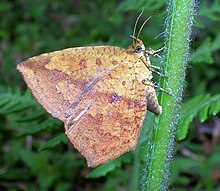Callidulidae, the only known family of the superfamily Calliduloidea, is the family of Old World butterfly-moths, containing eight genera. They have a peculiar distribution, restricted to the Old World tropics of Southeast Asia to Australasia and Madagascar. The three subfamilies exhibit both day- and night-flying behaviour.
| Callidulidae | |
|---|---|

| |
| A callidulid moth Tetragonus catamitus laying eggs on a fern in the Western Ghats. | |
| Scientific classification | |
| Domain: | Eukaryota |
| Kingdom: | Animalia |
| Phylum: | Arthropoda |
| Class: | Insecta |
| Order: | Lepidoptera |
| Clade: | Eulepidoptera |
| Clade: | Ditrysia |
| Clade: | Apoditrysia |
| Clade: | Obtectomera |
| Superfamily: | Calliduloidea |
| Family: | Callidulidae Moore, 1877 |
| Subfamilies and genera | |
|
Pterothysaninae Minet 1987 Griveaudiinae Minet, 1990 | |
| Diversity | |
| About 60 species | |
The mainly day-flying Callidulinae can be distinguished by their resting posture, which is the most butterfly-like, with the wings held closely over the back. Resembling the butterfly family Lycaenidae, these moths can be told apart by their antennae which taper to a point or may be very subtly clubbed. The more often night-flying Pterothysaninae and Griveaudiinae have a different adult resting posture (the latter roof-like in repose) and these were not placed within the Callidulidae until recently.[1]
Biology of most subfamilies and species is poorly known. Eggs are very flat in Griveaudiinae and Callidulinae, and caterpillars of Callidulinae are green with a shiny black head and have only been reported from ferns[2] forming a leaf roll in which they live, eat and finally pupate, while the pupa of Helicomitra appears to be subterranean.[3]
The closest relatives of Callidulidae are not known, but they are currently placed in a group that includes the three butterfly superfamilies, the "hook-tip moths" Drepanoidea and the "geometer moths" Geometroidea and also possibly Axioidea which share some structural characteristics.[4]
Cited references
edit- ^ Minet, J. (1986). Ébauche d'une classification moderne de l'ordre des Lépidoptères. Alexanor 14(7): 291–313.
- ^ Gaden S. Robinson, Phillip R. Ackery, Ian J. Kitching, George W. Beccaloni & Luis M. Hernández. HOSTS database. [1][permanent dead link] (Accessed May 2007)
- ^ Minet, J. (1987). Description d'une chrysalide de Pterothysaninae (Lep. Callidulidae). Nouvelle Revue d'Entomologie (N.S.) 4(3): 312.
- ^ Minet, J. (1999 [1988]). The Axioidea and Calliduloidea. Ch. 16, pp. 257–261 in Kristensen, N.P. (Ed.). Lepidoptera, Moths and Butterflies. Volume 1: Evolution, Systematics, and Biogeography. Handbuch der Zoologie. Eine Naturgeschichte der Stämme des Tierreiches / Handbook of Zoology. A Natural History of the phyla of the Animal Kingdom. Band / Volume IV Arthropoda: Insecta Teilband / Part 35: 491 pp. Walter de Gruyter, Berlin, New York.
Other references
edit- Minet, J. (1990 [1989]). Nouvelles frontières, géographiques et taxonomiques, pour la famille des Callidulidae (Lepidoptera, Calliduloidea). Nouvelle Revue d'Entomologie (N.S.) 6(4): 351–368.
- Maddison, David R. 2003. Callidulidae. [2] in The Tree of Life Web Project, [3] Accessed October 2006
- O'Toole, Christopher (Ed.) (2002) Firefly Encyclopedia of Insects and Spiders. ISBN 1-55297-612-2
External links
edit- Tree of Life
- Natural History Museum hosts database[permanent dead link]
- LepIndex list of species and genera in superfamily Calliduloidea
- Moths of Borneo Callidulidae
- Moths of Borneo Callidulinae images
- Callidulinae species
- Callidula attenuata Accessed 4 March 2007
- Photo illustrating rest position